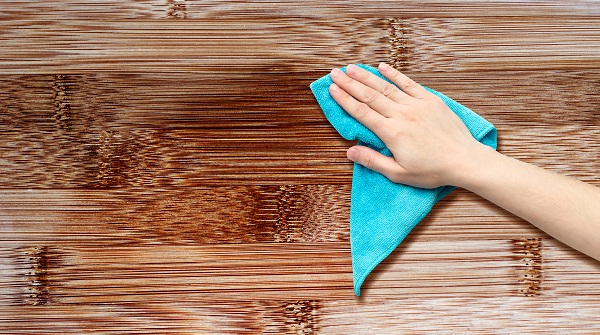Follow the simple but effective cleaning schedule provided here, and your hardwood floors will be sparkling and inviting.
Follow your mops manufacturers recommendations on whether you should use a wood floor polish or a dusting solution; some mop products will not need any additional cleaning products. Then create your own cleaning mix using either a mild cleaner or several drops of daily washing detergent/dish soap mixed with approximately 4 cups warm (not hot) water.
If this is done, clean hardwood floors thoroughly every two or four weeks…, and then mix your cleaning solution together and use a regular mop (a mop that has hands-free wringing makes this task easier) or you can use a microfiber mop. To more thoroughly clean sealed hardwood floors, use a wet mop with a water solution and the cleaning solution for your hardwood floor, which is of your choosing. You will want to start off using the best mop you own, and from there, it is just learning how to carefully clean hardwood floors using products or even just plain water as a natural alternative.
For the way to clean your hardwood floors thoroughly (consider doing this clean-up during springtime or right before winter holidays), use both the Wood Floor Mop and Wood Floor Cleaning products, dilute according to label instructions. If your floors are not brand new, or if you cannot check with the floor manufacturers, choose a product specifically designed to clean wood floors. Your flooring installer has probably recommended floor-cleaning products that should be used to scrub, but sometimes you cannot use these products, whether because of cost or availability.
In most homes, the best floor cleaner for wooden floors is just plain old soap and water, and the only tools needed are a broom, a vacuum, and a mop. If you are wondering how to clean hardwood floors daily, or what is the best way to clean laminate hardwood floors, particularly when you are tight on time – the easiest thing to do is use a robot vacuum.
To help ensure that your finish stays shiny and clean, you need to sweep, sweep, or dust mop your hardwood floors every day, and clean spills immediately after they occur. This finish, which is technically a surface finish, can be cleaned just like you would clean your floor with urethane.

These finishes can readily absorb water, and water will cause the wood floors to warp, so use solvent-based cleaning products instead of water-based products for floors with penetrating finishes. If your floor has penetrating finishes, the best way to deep-clean is to strip off smudged older coats of wax and apply fresh layers of wax. For best results, use liquid waxes or paste waxes specifically designed for hardwood floors (acrylic or water-based waxes may stain wood surfaces).
Wood flooring manufacturers and wood laminate floors beg you to avoid using vinegar in the cleanup process because vinegar is an acid that will damage your floor’s surface. When cleaning, it is important to remember to never wet your wood floors because this could strip away the finish, or possibly cause warping or degrade. If necessary, end each cleaning session by staining the wood, and then waxing and polishing the spots so they are consistent with the rest of your floors.
If you do not have apple cider vinegar handy, alternatively, add a half-cup of white vinegar to one gallon of water for cleaning any kind of floor. Another advantage to using apple cider vinegar and water to clean hardwood floors is that it does not leave behind a film and does not need rinsing as do many store-bought cleaning products or those that are chemical-based.
Solid and engineered hardwood floors may get the same cleaning regimen, but never use a hardwood floor cleaner on laminate because timber oil and waxes in the ingredients may dull the surface.
If your engineered hardwood floor is still looking dull or dull after being dusted, then clean it thoroughly using any pH-neutral, wax-free, petroleum-free cleaner, like Bona PowerPlus Hardwood Floor Deep Cleaner or a DIY solution consisting of one-fourth cup of dish soap and one gallon of hot water. You should perform more extensive cleaning on your floors on a weekly or monthly basis, depending on how much use your floors receive.
As painful as it sounds, even a weekly sweep is crucial for keeping the house clutter-free, and it ensures that all of the debris and dirt that you missed when sweeping does not scuff up the floors. Some people skip straight to sweeping the dustpan or mopping their floors, but I prefer sweeping them with a broom first, so that the larger particles are collected. Using a dust mop rather than a broom allows you to pull in and pick up dirt, rather than pushing it around on the surface of your floor and possibly scraping.
All you have to do is sweep every day, if you can, and vacuum regularly using either a Hard Floor setting, which disables the brush rollers to prevent scratches, or a Flathead attachment, which protects your floor from bristles. The Flooring Association recommends that you sweep or dust-mop daily, and you should vacuum with the hard floor attachment once per week.
When it is time to clean floors, apply a gentle application of one of our recommended products and work in small, square, three-foot sections to prevent wetting your floors too much.
Along with space for sitting down and space for shoes, have a clean cloth or towel hidden near your doorway for quick cleaning up of stray puddles on wooden floors. The best way to give wood floors a little TLC is to keep shoes out of the door, regularly vacuum to get rid of abrasive dirt and dust (with either a straight-up vacuum or one that has its rotating brush turned off to avoid scratches), promptly wipe down spills, and keep your pets nails clipped.
